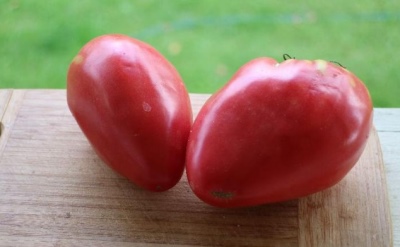
- Authors: Italy
- Name synonyms: Work Release Paste
- Category: grade
- Growth type: indeterminate
- Appointment: universal
- Ripening period: mid-season
- Ripening time, days: 110-115
- Growing conditions: for closed ground
- Bush size: tall
- Bush height, cm: 180-200
The selection of Mediterranean countries in Russia is poorly known, but there are also quite tangible achievements there. So, Italian agricultural specialists can boast of a tomato Paste working release. This crop at least deserves attention from farmers.
Breeding history
As already mentioned, the Working Pasta Edition was created in Italy. There he was also given an official synonym - Work Release Paste. The suppliers of planting material do not provide any more details, including about registration in the state register of the Russian Federation.
Description of the variety
The working production of the paste will develop according to an indeterminate pattern. This culture belongs to a universal category. It is mainly grown indoors. The height of the bushes can reach 1.8-2 m. Thin leaves seem to "droop".
The main qualities of the fruit
The berries of this variety have a simple raspberry color. They are large and usually weigh 200-300 g. The largest specimens can pull 0.5-0.6 kg. In shape, the fruit resembles an elongated spear. The surface of the berries is strong enough, 1 brush contains 4 or 5 of them.
Taste characteristics
The harvest is actively used fresh. And also it can be used as a raw material for sauces and tomato paste. Although the Tomatoes of the Paste Working Release are strong, their peel does not negatively affect the perception of the plant. The pulp of this variety is fleshy and juicy. The official description also emphasizes such advantages as:
sweetness;
tender sensation;
lack of seeds;
"Creamy" impression.
Ripening and fruiting
The plant belongs to the mid-season category. Typically, the harvest will be ready in 110-115 days after the emergence of young green growth. However, in a number of situations, the weather negatively affects the result. Positive impact is also possible, but it is much less common.
Yield
The fertility of the variety can vary over a fairly wide range. It is declared at the level of 8-12 kg per 1 sq. m. It is easy to understand that this result ultimately depends equally on both meteorological conditions and cultivation measures.
The timing of planting seedlings and planting in the ground
Only seedlings that develop within 60 days can be considered mature. Special dates for planting this particular variety are not spelled out. However, you can follow the same approaches as for other mid-season tomatoes. Usually, seedlings begin to be dealt with in the first half of February. With this approach, most often it manages to get stronger and develop by the very beginning of the warm season.

Growing tomato seedlings is an extremely important process, because it largely depends on whether the gardener will be able to harvest at all. All aspects must be taken into account, from seedbed preparation to planting in the ground.
Landing scheme
In the available sources, the planting scheme for this variety is not characterized in any way. It can be assumed that one should be guided by the constellations that are universal for most varieties.

Growing and care
Step-by-step tomato A working release of pasta will have to be done in any case. And also it is worth remembering that it must be formed into 1 stem. Cultivating this sort is pretty easy. It should be borne in mind that tomatoes have a developed, powerful root system. Therefore, it is necessary to avoid excessive irrigation of them at the very beginning of development, so that the roots have time to strengthen and penetrate deeper.
Seedlings for the most active development must be highlighted. Air humidity for it should be about 65%. Seedlings are recommended to be hardened before planting. The use of supports will be required. Weeding plays an important role.




A plant needs different micronutrients at each stage of growth. All fertilizers can be divided into two groups: mineral and organic. Folk remedies are often used: iodine, yeast, bird droppings, eggshells.
It is important to observe the rate and period of feeding. This also applies to folk remedies and organic fertilizers.
Disease and pest resistance
Cracking of berries is quite likely for this variety. Other ailments and pests are not described. Therefore, it is advisable for gardeners to protect their plantings from as many threats as possible. Preventive treatments with insecticides and other pesticides will be required. It is better to use potent agents according to the instructions, and for prophylactic purposes, as far as possible, replace with natural substances.



























































































